02.26.2012 original publish date
05.02.2013 update intro, minor edits, replaced broken links, numbered [brackets] added for easier referencing
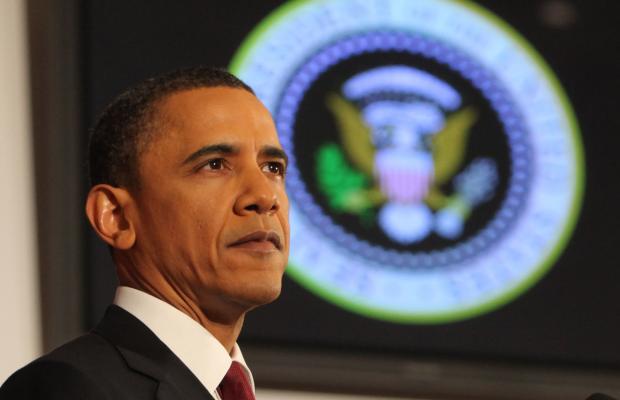
Oil Prices Up 178% Under Obama – U.S. Handing Russia Our Land & Oil
original article written by Net Advisor™
WASHINGTON, DC. The U.S. continues to be dependent on foreign oil, despite the fact the U.S. has the ability to drill or otherwise obtain its own domestic energy. Using our own energy can be a source of new high paying jobs, and decrease taxpayer’s money handed to foreign governments, some of whom have policies that aren’t in alignment of U.S. true National Security interests.
The U.S. goverment just sits back and talks about green energy which has a place. The problem is that wind, solar and other alternative energy sources may quite possibly be 30-100+ generations away from becoming a reliable, primary sources of energy that is also not only affordable without goverment subsidies, but also has the ability to supply most of America’s energy on an on-demand basis.
For now, the U.S. needs to address using domestic energy including oil, natural gas, and oil from shale. Doing little to nothing about new U.S. domestic drilling has brought us here:
[1] Oil Prices Soared Since President Obama Took Office in 2009
U.S. oil prices have risen by 178% since January 2009 to February 23, 2011.
On Inauguration Day, January 20, 2009 U.S. Crude (West Texas Intermediate) for February delivery was $38.74 barrel in New York Trading (Source: Bloomberg). As of 02-23-2011, U.S. Crude was trading at $107.83 a barrel (Source: Reuters).
Thus U.S. oil prices are up $69.09 a barrel or up 178% since Obama took office – about 8% higher than last year.
[2] Brent Crude Oil Hits Record High
Brent Crude Oil hit a record high on 02-23-2012 said Reuters.
“Brent rose 72 cents, or 0.59 percent, to settle at $123.62 a barrel, while U.S. April crude rose $1.55, or 1.46 percent, to settle at $107.83 a barrel.”
— Source: Reuters
[3] Brent Crude Oil Prices Up 199% Since President Obama Took Office
Brent Crude Oil prices are causing some concern about a potential negative impact this summer on the U.S. and European economies. Brent Crude Oil prices have soared $82.40 or +199% since President Obama took office.
On January 20, 2009 Brent Crude Oil was $41.22 a barrel (Source: Historical Price Chart: PDF HTML).
As of 02-23-2011, Brent Crude Oil was trading at $123.62 a barrel. Thus Brent Crude oil prices are up $82.40 a barrel or up 199% since Obama took office (Source: Historical Price Chart: PDF HTML).
President Obama has argued that oil prices (gas prices) are up because of the Middle-East crisis – namely with Iran. We’ll, this is part true. What is not being included in this argument is that there has always been some sort of crisis in the Middle-East. In terms of oil-related crises, this has been ongoing for some 50 years as the following chart shows.
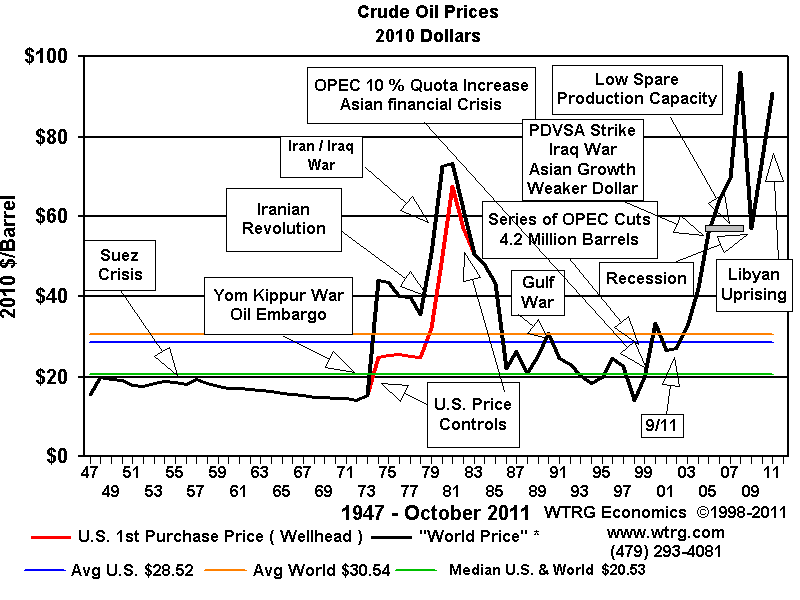
[4] Obama to Give Away U.S. Owned Oil Rich Assets to Russia – for FREE
The President acknowledging that oil prices are going up recently, but Obama has not acknowledged that oil prices have skyrocketed since he took office with his anti-domestic oil policies. Clearly, with the U.S. having such an abundance of domestic energy, it’s time to start giving away our oil, and our own sovereign land?
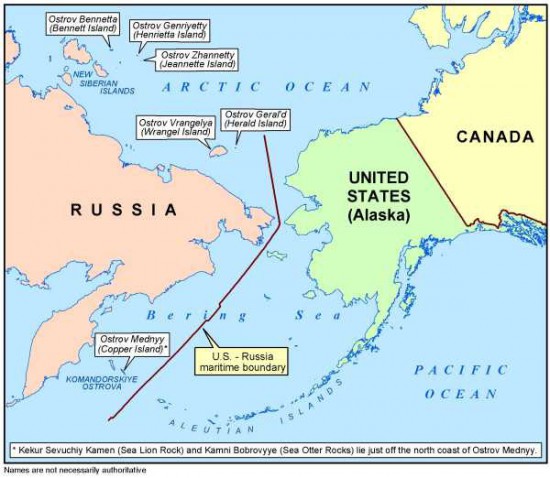
[5] No Domestic Drilling? How About Giving U.S. Oil to the Russians?
President Obama has hit a new low with the Administration’s anti-domestic energy policy. The Administration is currently planning to hand over seven islands under U.S. – Alaska ownership to Russia. The U.S. held interest in these islands reportedly since 1881.
The U.S. (Alaska) islands cover a collective area the size of “Rhode Island and Delaware combined.” This island giveaway, also hands Russia control of billions of barrels of U.S. oil.
And what will the U.S. get in return for handing over U.S. land and oil to Russia? The “fair share” price of course = $ZERO.
The United States will get zero economic benefit from this deal as President Obama is giving all this U.S. land and U.S. oil resources to Russia – for FREE (Source: World Net Daily).
If there were just 1 billion barrels of oil in this area, based on the lowest U.S. crude oil prices as of 02-23-2012 ($107 bbl), that would amount to giving Russia $107 Billion in cash. According to WND, “The Department of Interior estimates billions of barrels of oil are at stake.” So for every billion barrels of oil, multiple that by the current oil price per barrel, and that is how much oil and money and land we are giving to Russia – for free.
The President could stop this hand-over to Russia, but that does not appear likely.
[6] President Obama’s Energy Policy: Higher Oil Prices?
If the 2009 goal of the Obama Administration is to have high energy costs, the President has succeeded. High energy costs impact everyone, not just the “1%” who can afford it, but the middle-class and the poor.
Everything in the USA is transported by either ship, plane or truck, and all use oil (gasoline, diesel or jet fuel). Those costs get passed on to consumers in the form of higher food and retail prices. If retailers and manufacturers can’t pass on their higher costs to consumers, expect to see jobs cuts.
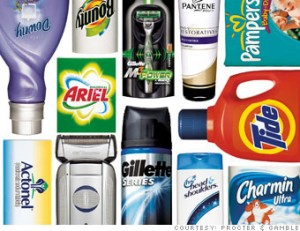
[7] Are Higher Oil Prices Impacting New Job Cuts?
On 2-23-2012, Procter & Gamble, the largest consumer home products manufacturer, announced plans to cut 5,700 non-manufacturing jobs to reduce costs.
P&G did not say whether these jobs cuts were directly due to higher oil costs. Like most consumer product makers, P&G uses oil (petroleum) such as in laundry detergents, dish soaps, and in plastic packaging. There has been some effort to reduce such use of petroleum in products and packaging, however it’s still widely-used. Jobs cuts may be a way where companies can reduce their costs in order to refrain from raising consumer prices too much.
Read more on bio-plastics:
Cola Wars Over Plant-Based Bottles Going Nowhere
Confusion Reigns Over Plant-Based Bottles
Officially, P&G’s jobs cuts are due from a period of “expansion.” We’ll if you are cutting 5,700 jobs, you’re not expanding right now, correct? And if you are still keeping your factories running at the same capacity, then it’s not a demand problem. It has to be something else. Could it be that higher petroleum prices are impacting costs at P&G? This would seem more logical given the fact that oil prices have more than doubled over the last three years.
[8] Airline Fares Ready to Take Off Due to Higher Oil Prices
One of the airlines biggest cost structure is the price of jet fuel. The commercial airlines are beginning to raise their airline ticket prices to help off-set their rising fuel costs. If oil prices are sustained over months at high levels, we are likely to see the impact of inflation on consumers.

[9] Obama’s Energy Policy:
If There Are Higher Oil Prices, Then People Will Buy Those “Green” Cars, Right?
I would argue that the intent of the Administration is to have high oil prices to encourage people to buy smaller, fuel efficient “Green” cars such as the over-priced Chevy Volt which by the way, few people are buying. In 2008, Obama said he wanted to see oil prices rise gradually so people and the markets can get used to higher (gas) prices.
Unfortunately for the Obama Administration this thinking has been incorrect. People are not buying green cars in mass based on political control over domestic manufactures. The reality is, despite higher oil prices, higher gas prices, and even during the worst recession since the Great Depression, Americans have not changed their auto buying habits.
In our 2011 report (about mid-page), despite the price of gas or oil, the #1 and #2 best selling vehicles in the U.S.A. for 2008, 2009, 2010, and 2011 are: the Ford F-150 TRUCK and the Chevy Silverado TRUCK.
[10] If It’s Bush’s Fault for $3 Gas? Who’s at Fault with $4 to $5 Gas?
When gasoline prices hit $3.00 gallon nation-wide under the Bush Administration, the Left pundits blamed President Bush and Vice President Cheney as ‘big oil supporters.’ Interestingly enough, despite the anti-oil rhetoric, and political blame game, President Obama has no problem taking campaign money from these same “big oil companies” (Source: Open Secrets.org).
[11] Video: “Gas Price Hypocrisy”
Gas prices are pushing $3.51 on average in the USA, however California is seeing the highest gas prices in the continental USA averaging over $4.00 a gallon. Some areas in California are already seeing $5.00+ a gallon gasoline. A former Shell Oil President predicted in 2010 that the U.S. would likely see $5.00 gas in 2012.
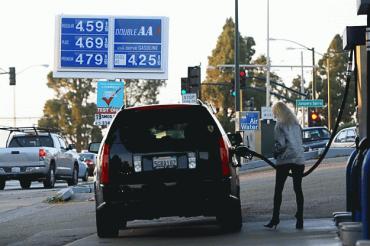
[12] No “Silver Bullet” to Lower Oil Prices?
The President said that there is no “silver bullet” for America’s energy crunch. In 2011, the White House attempted to control oil prices by releasing some of the U.S. Strategic Oil Reserves along with the International Energy Agency (IEA) for a whole month. This was a temporary fix, and this strategy has never worked long-term.
Oil is a global free market, and prices are impacted by two things: (1) supply and demand; and (2) the value of the U.S. Dollar. The U.S. just does not have the ability to control the price of oil…unless the U.S. adopts a legitimate strong dollar policy. However, that would require no more deficit spending, actually paying down the U.S. deficit using real numbers, and using our own energy resources. This means domestic drilling until a national and more more economic alternative can be found and replaced. So, yes, we are going to pay a lot more for gas and consumer products in the future, and will have fewer dollars to do this. Welcome to Obamanomics.
Read More About the Deficit:
The Truth About the Budget Cuts
Countdown to Deficit Cuts – But Still a Deficit (a 5 part series)
Obama Deficit to Exceed 8 Years of Bush in Half the Time
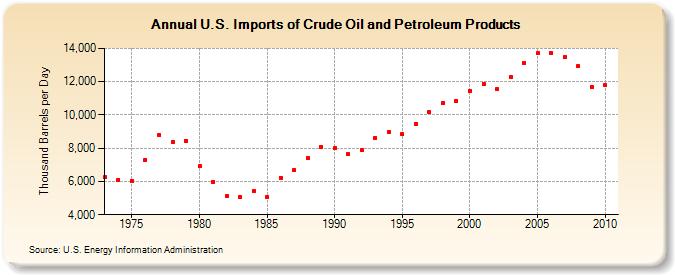
[13] Obama says U.S.A. Less Foreign Oil Dependent? – (Not Really).
President Obama recently defended high oil prices suggesting that U.S. oil imports are the lowest in 30 years:
“In 2010, our dependence on foreign oil was under 50 percent for the first time in 30 years…”
— Barack Obama (Source: ABC News)
[14] Fuzzy Math
We are not sure where Mr. Obama is getting this so called ‘decrease’ of U.S. oil dependency information. The latest oil import data was published by the U.S. Energy Information Administration (EIA.gov) in 2011. The next report is due 07-31-2012 (Source: EIA.gov – highlighted dates). So we examined the President’s statements against the government’s own data. Using the chart above, here are our findings:
According to the government’s own data since about 30 years ago (1982), U.S. annual imports of crude oil and petroleum products have increased by roughly 140%.
— Source: U.S. Energy Information Administration (Chart above – PDF HTML).
Math: Est. 5 million bbls imported oil/ day in about 1982. By 2010 we had about 12 Million bbls imported oil/ day. Thus 12 – 5 = 7 Million bbls net increase of imported oil/ day. Then 7 divided by 5 = 1.4 (or 140%) net increase of imported oil/ day.
[15] U.S. Importing More Foreign Oil Under Obama
In 2009, the U.S. imported 11,691 barrels of oil per day from all sources. By 2010, the U.S. imported 11,793 barrels of oil per day. Thus the U.S. is importing 102 more barrels of oil per day under Obama (Source: U.S. Energy Information Administration – PDF).
[16] Does the U.S. Really Get Most of Its Oil From Canada and Mexico? – (Not Really).
In 2010, the U.S. imported a total of 2,535 barrels of oil per day from Canada and 1,284 barrels per day from Mexico (3,018 total). At the same time, the U.S. imported a total of 4,906 barrels of oil per day from OPEC member nations including 988 barrels a day from Anti-U.S. radical Hugo Chavez‘s Venezuela. Thus, collectively the U.S. gets most of its oil from the OPEC member nations. (Source: U.S. Energy Information Administration – PDF).

[17] Iran
Part of the recent run up in oil prices is that the Obama Administration has sought sanctions against Iran. Another part has to do with the “mini Ice Age” occurring in Europe. This has increased demand for heating oil.
The Iranian sanctions include seeking other countries to cut back or stop importing Iran’s oil. The U.S. has not imported oil from Iran since about 1979. The U.S. has done nothing to increase any material domestic energy development to off-set foreign oil dependence. As much as solar and wind power sounds like a good idea, it will not power American cars, trucks, homes, factories, buildings, etc., overnight or anytime soon. While working toward those lofty goals, we need energy now, and using our own domestic resources is a cost effective solution.
If Obama was serious about crippling Iran’s economy, cutting off some oil sales is only part of the answer. The real answer is preventing anyone outside of Iran to conduct any financial transactions with Iranian banks, especially the Iranian Central Bank. Despite a 100-0 vote in favor by the U.S. Senate to tighten financial reign over Iran’s government in 2011, Obama opposed that action. Later Obama signed the bill, but sought that it was “non-binding.”
Fact Sheet: An overview of O.F.A.C. Regulations involving Sanctions against Iran.
— Source: U.S. Department of the Treasury, PDF
The probability of higher oil prices seem obvious to us. This summer, oil prices could hit new record highs with the changeover of more expensive ‘environmentally friendly” fuels.
“Reformulated gasoline (RFG) is gasoline blended to burn more clearly than conventional gasoline and to reduce smog-forming and toxic pollutants in the air we breathe. The RFG program was mandated by Congress in the 1990 Clean Air Act amendments.”
— Source: EPA.gov
[18] Summary with the ‘Bear’ Facts
The Administration has done nothing to address U.S. oil prices from climbing 178% under Obama’s watch. The Obama Administration seems to have a disconnect from believing that we are importing less foreign oil, when the government’s own data is showing an increase. This Administration continues to support higher oil prices, and Obama publicly stated he wants to see oil prices rise gradually. As a result, it appears that U.S. jobs may be impacted by higher oil prices, and rising consumer prices could also have an impact on the fragile economy.
The Administration has the view that higher oil prices will get people to buy greener cars. The reality is, despite gas prices and a recession, Americans favor large trucks over smaller cars. Speaking of cars, the President seems to think that if we just inflate our tires, we wouldn’t need to import all this oil? (Video).
The President’s solution to America’s energy use is to convert to mostly solar and wind power, tax oil companies, and blame Republicans. The U.S. cannot just put up solar panels and windmills to power cars, trucks, every home, factories, airlines, or military hardware, etc. This is just not a realistic near-term and arguably not a realistic long-term goal.
Using alternatives fuels is a start, but in the meantime, we need to develop our own existing energy for our immediate domestic use. The President has made it difficult or outright blocked domestic U.S. energy plans which also can boost well paying U.S. jobs.

Although polar bears are cute, and sure, we can create protected reserves for them; the question is do we need to give the bears 187,000 square miles of land to roam? This includes about 13,000 square miles of Alaska. For the rest of us, you are lucky if you have a couple thousand square feet to raise a family. I’m not suggesting polar bears have a couple thousand square feet to live in, just asking is it absolutely necessary that we block off 187,000 square miles of land and sea?
Based on doing a little research for this article, I’d take the cynical view that the White House isn’t interested in saving polar bears as much as there is interest in preventing anyone from using our own domestic gas and oil reserves.
To further support this argument, all one has to do is separate at the behavior from the rhetoric. Instead of developing our own existing oil and gas resources, this President is now giving away valuable and strategic U.S. land with our own oil resources to Russia – for free.
Any person of sound mind should clearly see that the Administration has little interest in developing our own immediate energy resources concurring with alternative energy. It seems alternate energy is the only way, but as this report has pointed out, this plan is not realistic to power the country anytime soon.
short link to this article: https://www.netadvisor.org/?p=12367
Images/ graphics may be copyright by their respective owners where known or credited.
original article content, Copyright © 2012-2013 NetAdvisor.org™ All Rights Reserved.
Disclosure: NetAdvisor™ and or private client(s) are currently long an oil ETF. Disclosure is mentioned because we discussed oil prices in this article. This position may change at any time without notice.
NetAdvisor.org® is a non-profit organization providing public education and analysis primarily on the U.S. financial markets, personal finance and analysis with a transparent look into U.S. public policy. We also perform and report on financial investigations to help protect the public interest. Read More.

